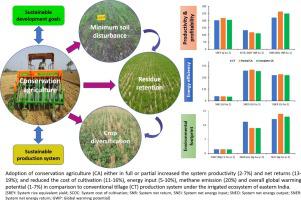Field Crops Research ( IF 5.6 ) Pub Date : 2021-05-03 , DOI: 10.1016/j.fcr.2021.108164 J S Mishra 1 , S P Poonia 2 , Rakesh Kumar 1 , Rachana Dubey 1 , Virender Kumar 3 , Surajit Mondal 1 , S K Dwivedi 1 , K K Rao 1 , Rahul Kumar 4 , Manisha Tamta 1 , Mausam Verma 1 , Kirti Saurabh 1 , Santosh Kumar 1 , B P Bhatt 1 , R K Malik 2 , Andrew McDonald 5 , S Bhaskar 6

|
In the eastern Indo-Gangetic Plains (EIGP), conventional rice-wheat system has led to a decline in productivity, input-use efficiency, and profitability. To address these, a four-year field study was conducted to evaluate the performance of tillage and crop establishment (TCE) methods in rice-wheat-greengram rotation. The treatments included: 1) random puddled transplanted rice (RPTR) - conventional-till broadcast wheat (BCW) - zero-till greengram (ZTG); 2) line PTR (LPTR) - conventional-till drill sown wheat (CTW) - ZTG; 3) machine transplanted rice in puddled soil (CTMTR) - zero tillage wheat (ZTW) - ZTG; 4) machine transplanted rice in zero-till wet soil (ZTMTR) - ZTW - ZTG; 5) system of rice intensification (SRI) - system of wheat intensification (SWI) - ZTG; 6) direct-seeded rice (DSR) - ZTW - ZTG; and 7) zero-till DSR - ZTW - ZTG. During the initial two years, conventional rice system (PTR) recorded a 16.2 % higher rice grain yield than DSR system. Whereas in the fourth year, the rice yields under DSR and PTR were comparable. As compared to SRI/SWI, the average wheat yield in ZT system was significantly high, whereas in rice, SRI/SWI system was comparable with CT system. ZTW after non-puddled rice was at par to CTW after PTR. The ZT wheat produced 4.6 % more yield than CT system. DSR production system consumed 6.8 % less water compared to transplanted system. On the system basis, 10.8 % higher net returns were recorded with CA-based system compared to conventional system. The system energy productivity under CA-based production system was 14–36 % higher than PTR-based systems. CA-based system also led to 8–10 % lower global warming potential (GWP) than conventional methods. The current study indicated that as compared to conventional system, a significant gain in productivity, profitability and energy-use efficiency, and reduction in the environmental mitigation are possible with emerging alternative TCE methods. Long-term expansion and further refinement of these technologies in local areas need to be explored for the second green revolution.
中文翻译:

稻麦作物可持续集约化农艺实践对印度恒河平原东部粮食安全、经济适应性和环境缓解的影响
在印度恒河平原东部(EIGP),传统的稻麦系统导致生产力、投入使用效率和盈利能力下降。为了解决这些问题,进行了为期四年的实地研究,以评估水稻-小麦-绿豆轮作中耕作和作物定植(TCE)方法的性能。处理包括: 1) 随机拌秧(RPTR)-常规耕作小麦(BCW)-零耕青麦(ZTG); 2)行PTR(LPTR)-常规耕作条播小麦(CTW)-ZTG; 3)水土机插稻(CTMTR)-零耕小麦(ZTW)-ZTG; 4)零耕湿土机插水稻(ZTMTR)——ZTW——ZTG; 5)水稻集约化系统(SRI)-小麦集约化系统(SWI)-ZTG; 6)直播水稻(DSR)-ZTW-ZTG; 7) 零耕 DSR - ZTW - ZTG。在最初的两年里,常规水稻系统 (PTR) 的稻米产量比 DSR 系统高 16.2%。而第四年,DSR 和 PTR 下的水稻产量相当。与SRI/SWI相比,ZT系统的小麦平均产量明显较高,而水稻方面,SRI/SWI系统与CT系统相当。非搅米后的 ZTW 与 PTR 后的 CTW 相同。 ZT 小麦的产量比 CT 系统高 4.6%。与移植系统相比,DSR 生产系统消耗的水量减少了 6.8%。在系统基础上,与传统系统相比,基于 CA 的系统的净回报率高出 10.8%。基于CA的生产系统的系统能源生产率比基于PTR的系统高14-36%。基于 CA 的系统还使全球变暖潜势 (GWP) 比传统方法降低 8-10%。 目前的研究表明,与传统系统相比,新兴的替代 TCE 方法可以显着提高生产率、盈利能力和能源使用效率,并减少环境影响。第二次绿色革命需要探索这些技术在当地的长期推广和进一步完善。









































 京公网安备 11010802027423号
京公网安备 11010802027423号